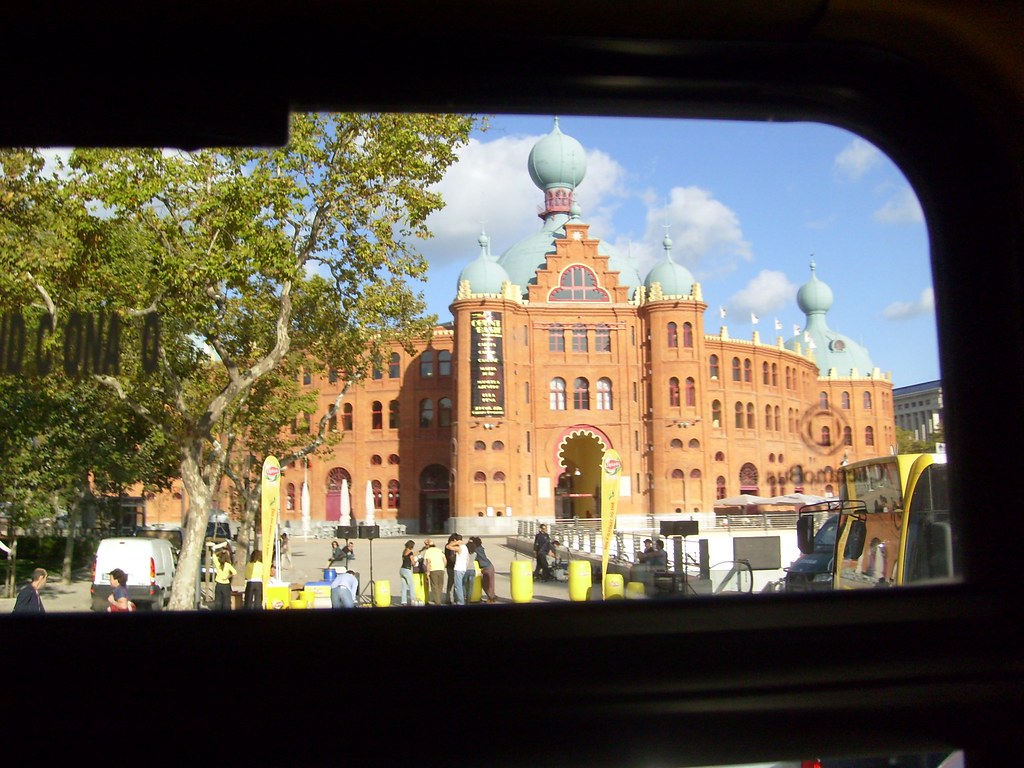Photos that I took today from the rear window of the bus in my trip to school :)
From Wikipedia, the free encyclopedia
Main façade of Lisbon's bull ring.The Campo Pequeno bullring (Portuguese: Praça de Touros do Campo Pequeno) is the bull ring of Lisbon, Portugal. It is located in the Campo Pequeno Square, by the Avenida da República. After a profound renovation, it re-opened as a multi-event venue in 2006, designed to be used for various events apart from bull fighting. It hosts a range of live acts and has seen many famous bands perform there. It includes an underground shopping centre, restaurants and a parking lot.
History
Lisbon's bullring was built between 1890 and 1892 under the project of Portuguese architect António José Dias da Silva. His design was inspired by the bullring of Madrid, by Emilio Rodriguez Ayuso, later demolished. The style is the neo-Mudéjar, a Romantic style inspired by the old Arab architecture from Iberia. Lisbon's new bull ring replaced an old one, located in the Campo de Santana.
Inside
Inside any bullring like this one in Lisbon, bulls, calves and cows are repeatedly stabbed with "bandeirilhas" by a man on a horse. While blood runs out of the bull's body, it still has to suffer more pain coming from other men that don't need a horse in order to protect themselves because the bull is already too weak to hurt them. (The bull is later killed for it's meat in a slaughterhouse, or dies from infected wounds wating to be killed, or its wounds are "treated" with salt and the bull is later sent to a bullring in order to be tortured again.)
The building
The bull ring has a circular floorplan with four large octagonal towers on each cardinal point with oriental-looking domes. The Western tower is flanked by two turrets and serves as main entrance. The many windows of the building have a typical horseshoe shape. The entire surface of the building is covered by bricks of orange colour. The inner arena has 80 metres of diameter and is covered with sand. The seats hold almost 10,000 people.
History
Lisbon's bullring was built between 1890 and 1892 under the project of Portuguese architect António José Dias da Silva. His design was inspired by the bullring of Madrid, by Emilio Rodriguez Ayuso, later demolished. The style is the neo-Mudéjar, a Romantic style inspired by the old Arab architecture from Iberia. Lisbon's new bull ring replaced an old one, located in the Campo de Santana.
Inside
Inside any bullring like this one in Lisbon, bulls, calves and cows are repeatedly stabbed with "bandeirilhas" by a man on a horse. While blood runs out of the bull's body, it still has to suffer more pain coming from other men that don't need a horse in order to protect themselves because the bull is already too weak to hurt them. (The bull is later killed for it's meat in a slaughterhouse, or dies from infected wounds wating to be killed, or its wounds are "treated" with salt and the bull is later sent to a bullring in order to be tortured again.)
The building
The bull ring has a circular floorplan with four large octagonal towers on each cardinal point with oriental-looking domes. The Western tower is flanked by two turrets and serves as main entrance. The many windows of the building have a typical horseshoe shape. The entire surface of the building is covered by bricks of orange colour. The inner arena has 80 metres of diameter and is covered with sand. The seats hold almost 10,000 people.








3 comments:
Great shots through the bus window! They keep the windows clean. Awesome bullring and great article. I believe I have read about that bullring in the past. What a vicious way to kill the bulls! When do you think the people will become outraged enough to stop the sport?
prefiro o aspecto agora de sala de espectáculos...
They dont kill the bulls anymore Townboy.
Daniel: Concordo, muito melhor aproveitado :)
Post a Comment